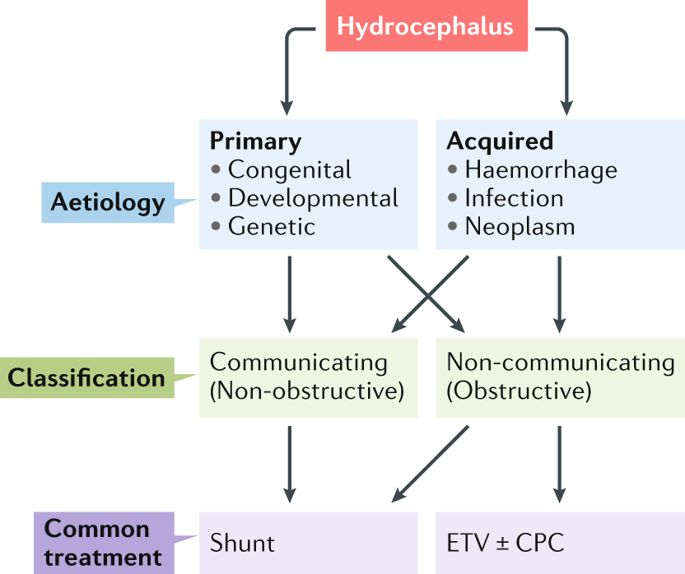当前位置:
X-MOL 学术
›
Nat. Rev. Neurol.
›
论文详情
Our official English website, www.x-mol.net, welcomes your
feedback! (Note: you will need to create a separate account there.)
Inflammation in acquired hydrocephalus: pathogenic mechanisms and therapeutic targets.
Nature Reviews Neurology ( IF 28.2 ) Pub Date : 2020-03-09 , DOI: 10.1038/s41582-020-0321-y Jason K Karimy 1 , Benjamin C Reeves 1 , Eyiyemisi Damisah 1 , Phan Q Duy 1 , Prince Antwi 1 , Wyatt David 1 , Kevin Wang 1 , Steven J Schiff 2 , David D Limbrick 3 , Seth L Alper 4 , Benjamin C Warf 5 , Maiken Nedergaard 6, 7 , J Marc Simard 8 , Kristopher T Kahle 9
Nature Reviews Neurology ( IF 28.2 ) Pub Date : 2020-03-09 , DOI: 10.1038/s41582-020-0321-y Jason K Karimy 1 , Benjamin C Reeves 1 , Eyiyemisi Damisah 1 , Phan Q Duy 1 , Prince Antwi 1 , Wyatt David 1 , Kevin Wang 1 , Steven J Schiff 2 , David D Limbrick 3 , Seth L Alper 4 , Benjamin C Warf 5 , Maiken Nedergaard 6, 7 , J Marc Simard 8 , Kristopher T Kahle 9
Affiliation

|
Hydrocephalus is the most common neurosurgical disorder worldwide and is characterized by enlargement of the cerebrospinal fluid (CSF)-filled brain ventricles resulting from failed CSF homeostasis. Since the 1840s, physicians have observed inflammation in the brain and the CSF spaces in both posthaemorrhagic hydrocephalus (PHH) and postinfectious hydrocephalus (PIH). Reparative inflammation is an important protective response that eliminates foreign organisms, damaged cells and physical irritants; however, inappropriately triggered or sustained inflammation can respectively initiate or propagate disease. Recent data have begun to uncover the molecular mechanisms by which inflammation - driven by Toll-like receptor 4-regulated cytokines, immune cells and signalling pathways - contributes to the pathogenesis of hydrocephalus. We propose that therapeutic approaches that target inflammatory mediators in both PHH and PIH could address the multiple drivers of disease, including choroid plexus CSF hypersecretion, ependymal denudation, and damage and scarring of intraventricular and parenchymal (glia-lymphatic) CSF pathways. Here, we review the evidence for a prominent role of inflammation in the pathogenic mechanism of PHH and PIH and highlight promising targets for therapeutic intervention. Focusing research efforts on inflammation could shift our view of hydrocephalus from that of a lifelong neurosurgical disorder to that of a preventable neuroinflammatory condition.
中文翻译:

获得性脑积水炎症:发病机制和治疗靶点。
脑积水是世界范围内最常见的神经外科疾病,其特征是由于脑脊液稳态失败导致充满脑脊液 (CSF) 的脑室扩大。自 1840 年代以来,医生已经观察到出血后脑积水 (PHH) 和感染后脑积水 (PIH) 的大脑和脑脊液空间有炎症。修复性炎症是消除外来生物、受损细胞和物理刺激物的重要保护性反应;然而,不当触发或持续的炎症可分别引发或传播疾病。最近的数据已经开始揭示炎症(由 Toll 样受体 4 调节的细胞因子、免疫细胞和信号通路驱动)促成脑积水发病机制的分子机制。我们建议针对 PHH 和 PIH 中炎症介质的治疗方法可以解决疾病的多种驱动因素,包括脉络丛 CSF 分泌过多、室管膜剥脱以及脑室内和实质(胶质淋巴)脑脊液通路的损伤和瘢痕形成。在这里,我们回顾了炎症在 PHH 和 PIH 致病机制中的突出作用的证据,并强调了治疗干预的有希望的靶点。将研究重点放在炎症上可以将我们对脑积水的看法从一种终生的神经外科疾病转变为一种可预防的神经炎症性疾病。脑室内和实质(胶质淋巴)脑脊液通路的损伤和瘢痕形成。在这里,我们回顾了炎症在 PHH 和 PIH 致病机制中的突出作用的证据,并强调了治疗干预的有希望的靶点。将研究重点放在炎症上可以将我们对脑积水的看法从一种终生的神经外科疾病转变为一种可预防的神经炎症性疾病。脑室内和实质(胶质淋巴)脑脊液通路的损伤和瘢痕形成。在这里,我们回顾了炎症在 PHH 和 PIH 致病机制中的突出作用的证据,并强调了治疗干预的有希望的靶点。将研究重点放在炎症上可以将我们对脑积水的看法从一种终生的神经外科疾病转变为一种可预防的神经炎症性疾病。
更新日期:2020-03-09
中文翻译:

获得性脑积水炎症:发病机制和治疗靶点。
脑积水是世界范围内最常见的神经外科疾病,其特征是由于脑脊液稳态失败导致充满脑脊液 (CSF) 的脑室扩大。自 1840 年代以来,医生已经观察到出血后脑积水 (PHH) 和感染后脑积水 (PIH) 的大脑和脑脊液空间有炎症。修复性炎症是消除外来生物、受损细胞和物理刺激物的重要保护性反应;然而,不当触发或持续的炎症可分别引发或传播疾病。最近的数据已经开始揭示炎症(由 Toll 样受体 4 调节的细胞因子、免疫细胞和信号通路驱动)促成脑积水发病机制的分子机制。我们建议针对 PHH 和 PIH 中炎症介质的治疗方法可以解决疾病的多种驱动因素,包括脉络丛 CSF 分泌过多、室管膜剥脱以及脑室内和实质(胶质淋巴)脑脊液通路的损伤和瘢痕形成。在这里,我们回顾了炎症在 PHH 和 PIH 致病机制中的突出作用的证据,并强调了治疗干预的有希望的靶点。将研究重点放在炎症上可以将我们对脑积水的看法从一种终生的神经外科疾病转变为一种可预防的神经炎症性疾病。脑室内和实质(胶质淋巴)脑脊液通路的损伤和瘢痕形成。在这里,我们回顾了炎症在 PHH 和 PIH 致病机制中的突出作用的证据,并强调了治疗干预的有希望的靶点。将研究重点放在炎症上可以将我们对脑积水的看法从一种终生的神经外科疾病转变为一种可预防的神经炎症性疾病。脑室内和实质(胶质淋巴)脑脊液通路的损伤和瘢痕形成。在这里,我们回顾了炎症在 PHH 和 PIH 致病机制中的突出作用的证据,并强调了治疗干预的有希望的靶点。将研究重点放在炎症上可以将我们对脑积水的看法从一种终生的神经外科疾病转变为一种可预防的神经炎症性疾病。











































 京公网安备 11010802027423号
京公网安备 11010802027423号